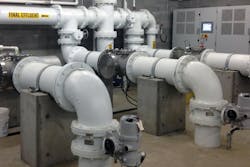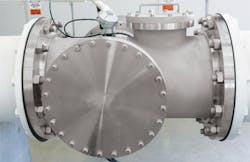UV Systems Help City Earn Energy Incentive
The city of Dundee, Ore., is a growing community with a strong economy that boasts three wineries within the city limits and several others in the surrounding Willamette River Valley. The city’s existing wastewater treatment plant (WWTP) was nearing its capacity, and the limited discharge to the Williamette River would not adequately support Dundee’s planned growth.
The Challenge
Since 2009, the city of Dundee has been working on a major expansion of its WWTP to upgrade an existing lagoon treatment system and small chlorine contact chamber into a new energy-efficient treatment facility. Kennedy/Jenks Consultants was hired to update the city’s facility plan and complete the permitting, pre-design, design and construction support services for improvements to expand the WWTP to 0.60 million gal per day (mgd) average annual flow, with expansion capabilities to 2.75 mgd peak flow in the future.
Rather than constructing a sequencing batch reactor (SBR) as recommended in the original facility plan, the consultant recommended constructing a membrane bioreactor (MBR). The MBR was selected because it penciled out with the same cost as an SBR, and the higher-quality effluent allowed the city of Dundee to obtain year-round river discharge rather than the seasonal discharge. The plan also allowed the city to evaluate the benefits of implementing energy recovery through the digestion of winery waste and other high-energy substrates while accommodating for the potential future expansion.
The Solution
With the year-round discharge, the city of Dundee was able to eliminate the lagoon and storage of water for non-discharge months. The ETS-UV closed-vessel disinfection system was selected in order to utilize a siphon system for discharge, maintaining a slight vacuum through the system, eliminating the permeate pumping required if open-channel ultraviolet (UV) was selected.
[Visit Evoqua's WWD Storefront]
The Class-A reclaimed water that this facility is able to produce is a major component of the city of Dundee’s ongoing goal to conserve the drinking water supply. The former sludge facultative lagoons (about 14 acres) will be decommissioned; the city plans to develop them as a nature park, including trails. The recycled water will be used for irrigation and other water features. The siphon system utilized by the closed-vessel UV system saves the city operating cost and earned energy incentives by reducing energy consumption. The city will benefit from the plant’s low gallon-per-capacity cost—less than $10 per gallon, which is very low for an MBR plant. The energy-efficient design resulted in the city being awarded an energy efficiency incentive from the Energy Trust of Oregon.

